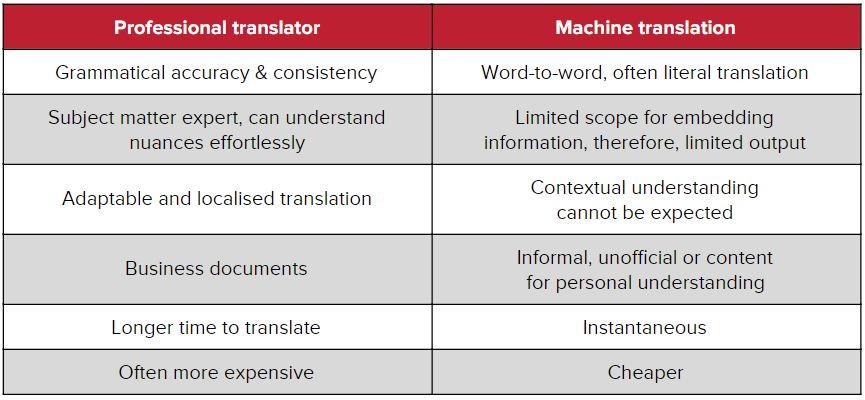In today’s fast-paced, competitive, multicultural world, the need for global companies to localise their marketing collateral such as their website is essential to their business’ success.
Not only does localising your marketing content expand your reach and credibility, it also increases customer engagement and retention, among many other things. Whilst the benefits of localisation are clear, you may be left wondering how to best tackle it.
Is it best to go for the quick, cheap option that ticks a box short-term, invest in a long-term plan which is more comprehensive or find a compromise in between? Between plain machine translation, machine translation post-editing and professional translation, businesses are spoilt for choice, but often left scratching their heads on which avenue to pursue.
Does this feeling ring true for you? Feeling a little lost in translation (pun intended)? No need to worry, we’ve all been there. Thanks to this article, you’ll walk away knowing more about your choices, before delving into the benefits of using a professional translator as well as discovering tips on how to choose the right option for your business.
Got your pen and paper ready? Let’s get right to it!
2 ways of translating for business purposes
When it comes to communicating on paper or online in another language, a business generally has 2 options: machine translation and professional translation.
Whilst both are relevant depending on your needs and desired outcome, it is important to know what they both refer to and how they differ in order to truly understand the impact they’ll have on your business.
Machine translation
Refers to automated translation that’s carried out by a machine, without human involvement.
Machine translation has greatly improved in speed and accuracy in recent years due to advances in technology.
Typically, machine translation works by using a computer software to translate text from one language (source language) to another language (target language).
Whilst Google Translate remains one of the most popular and most widely used pieces of free online machine translation software, there are many others to choose from as well.
Professional translations
This term refers to translations that are completed by linguists who have relevant tertiary qualifications in translation and / or sufficient industry experience.
It’s worth mentioning that although polyglots are very talented with languages, knowing how to speak and write in several languages doesn’t qualify someone as a professional translator.
Professional translators use their creative skills or deep knowledge of a given industry to find the most appropriate and relevant phrases or expressions in order to convey the correct intended message.
The real difference
The aim of this article is not to disparage machine translation, but simply to realise that it cannot offer the same value a human translator can. As such, we’ve highlighted the main differences between the two keeping in mind that the choice of one over the other will mainly depend on your circumstances and needs.

4 Benefits of Hiring a Professional Translator
Now that we’ve delved into the various benefits and characteristics of each translation style, the question remains “why would you need a professional translator?” Or alternatively, “how do you know when you can get away with pure machine translation?”
First thing’s first, ask yourself “what are my needs?” “Who is going to read my content?” “What is the long-term impact that this content will have on my business?”
When looking to fulfil a need, it is natural to lean towards the fastest, and often the cheapest solution. In that sense, machine translation will tick both of those boxes. But when business goals are on the line, machine translation simply cannot compete with a human translator. Here’s why:
SEO
In the past few years, businesses have focused a great deal on SEO (Search Engine Optimisation) to improve their site’s ranking, attract more traffic, enhance their digital brand awareness and, of course, convert traffic into more business. In today’s SEO arena, a business must invest in its brand so as to gain a standing with search engines.
So whilst the traditional approach was once to focus on (word for word) translation, companies are now expected to adapt their content to resonate and engage with their target markets. To do this successfully, SEO needs to be woven into the translation process and adapted to your different markets.
Machine translation is not advanced enough to be able to take SEO considerations into account. This is where a professional translator can make all the difference.
Indeed, an experienced translator will have the skill set and understanding of how to tailor your content to your target market, whilst also appealing to a search engine’s algorithm. All in all, a human translator can make your digital objectives a priority, whilst a machine will not have that ability.
Brand Voice
When people think of “branding”, they tend to recall the visual identity of a brand. No wonder since fonts, colour schemes and logos, as well as other visual queues, tend to leave a long lasting impression.
Nonetheless, branding encompasses a lot more than what meets the eye, and brand voice is one of its most critical features. In our digital world, brand voice is actually one of the most efficient ways to differentiate yourself from your competition. And to achieve this, consistency is key.
Unsure what brand voice entails? It’s the distinct personality a brand takes on in its communications which is part of its brand guidelines. Your brand’s tone of voice is representative of your brand’s personality. It “speaks” for your company and so plays an incredibly critical role, acting as your brand persona.
During the translation process, a translator will have your brand guidelines in mind and adapt the content to match. This ability is something peculiar to humans and cannot (yet) be provided by machines.
Context
In the same vein as with brand voice, context is critical when translating content and even more so when localising. In fact, context can make or break an idea or concept.
By context we mean taking into account the entire environment in which the word or sentence is expressed or stated. Since we perpetually interact with our environment, when and where we interact determines what we mean and wish to communicate.
For example the word ‘March’ refers to an act as well as a month. The meaning depends on the when, where and how. In other words, its meaning depends on the context.
With that in mind, there’s no wonder why context is crucial in providing clearer directions to our audience, unlocking both spoken and unspoken meanings.
A professional translator will take context into account when translating, contrary to a machine, which only knows how to translate in vacuo.
Fluidity
When translating a text from one language to another, doing so word by word will most likely degrade the flow of the sentence or even of the paragraph. This will of course result in an incomprehensible or inaccurate message, most likely damaging your reputation.
In addition to this, comes the colloquial phrases unique to every language. In English, we’re all familiar with the expression “raining cats and dogs”. Once translated though, it loses all meaning. Instead, localisation is about finding its equivalent in your target language rather than translating word for word.
Accurately translating the content, whilst also conveying the essence of the text is a translator’s main responsibility. Achieving both of these is a balancing act. A professional translator will understand the nuances of source language and will be able to reproduce it in a natural way.
How to choose the right option for your business
As determined earlier on, using the right approach when it comes to translation and localisation is critical for your business. Choosing between using a machine translation software or a professional translator can be tricky so here are the main reasons why you’d choose one option over the other.
When you may want to go with machine translation in a nutshell:
– If you need a piece of content as soon as possible
– If you have a limited budget
– In times when a rough translation will suffice (e.g. for low priority internal messages)
When you may want to go with a professional translator in a nutshell:
– When you need a high level of accuracy (e.g. for legal or highly technical documents)
– For marketing or creative collateral (this is where the importance of transcreation comes in)
– If the goal is to target a multicultural & multilingual audience
– When you’re after long-term success and don’t have immediate budget constraint
Another option which is growing in popularity is post-editing. This technique combines both machine and human contribution and involves a professional translator intervening to review and improve the text once it has been automatically translated. Although this option is available, post-edition is not to be chosen lightly. For instance, we wouldn’t recommend this route for marketing or very specialised content.
Why? Because this kind of content is either complex, plays with words or both. In Marketing for instance, you’ll find figures of speech and a desire to be punchy which aren’t components that machines can easily comprehend.
Were you to choose automated translation in conjunction with post-editing, you also risk spending more money than intended. Indeed, if the translator has to sort through gibberish and rewrite everything from scratch, there’s a high chance they’ll end up charging more than if you’d collaborated with them in the first place.
All in all, given that communication is a big part of building (and maintaining) a strong reputation, making sure it’s accurate and on point is paramount. Hence, professional translators remain your best course of action. Nonetheless, we understand that this comes at a cost. As such, an alternative could be to use a combination of machine and professional translation until your business can afford to invest further.
Whichever option you end up choosing, what’s important to consider is the cost of professional translation versus the potential monetary and reputational costs of having a low-quality translation. If a professional translation can save you the headache of dealing with miscommunication down the line, then it’s the logical choice.
Want our help deciding which would best serve your needs? Reach out! We’re here to help you communicate globally!













 November 4, 2022
November 4, 2022 






